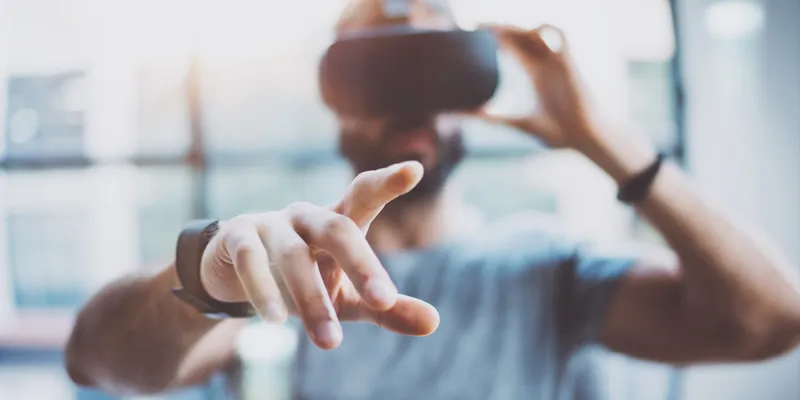Driving marketing in the 21st century with VR and AR
VR and AR technologies will redefine the dissemination of brand information, interactions between buyers and sellers, and the overall shopping experience.
If there is one function of businesses that is always receptive to latest technology and innovations, it is marketing. When printing was invented, the hand-written messages were replaced by catalogues, pamphlets and posters.
With the advent of digital technology, there were LED displays, audio-visuals, social media, and websites to reform the domain. In recent years, a buzz was created by AI-powered interactive displays and now the latest disruption is being led by virtual reality (VR) and augmented reality (AR).

Before delving into how these two technological breakthroughs are going to transform marketing in the third millennium of human existence, we need to get a better understanding of what VR and AR bring to the table.
Virtual reality
VR is a computer simulated environment which provides the user with an immersive experience. Simply said, instead of watching action unfold on display screens in front of us, VR creates a 3D interactive environment around the users. It incorporates various senses such as sight, sound and even touch or smell to create an artificial world.
The immersive feel that VR provides can be incredibly useful in marketing products. Merrell, a leading manufacturer of custom hiking shoes planned the launch of their new hiking boot ‘Capra’, and opted to create a VR experience to create the buzz at the launch event.They came up with a VR experience called ‘Trailscape’ that took the users on a dangerous virtual hike on a mountainside. They walked on a stage mapped virtually to create superior immersive experience of the actual mountain hike. They incorporated motion sensors, tactile elements like rope walkways and shaky wooden plans to create one of the best immersive VR experiences until now.
Augmented reality
AR is also a computer-generated simulation but works in a manner opposite to VR. Unlike VR, it doesn’t put the user inside a simulated environment, but rather augments reality by adding simulated objects, displays and creatures to the user’s actual physical surroundings.
AR came into existence in 1992 when Louis Rosenburg from the USAF Armstrong’s Research Lab came up with a technology called ‘Virtual Fixtures’ that added information on top of physical objects. Boeing later used the same concept at its factories where aircraft engineers used AR to visualise wire layouts on physical boards using CGI.
AR can take interactive marketing to a whole new dimension. The customers can be given real-time tech created experiences right in the middle of their actual surroundings.
The global cola giant Pepsi created an AR-based ad for Pepsi Max in the year 2015, and it was a fantastic display of how the technology can be used in marketing. They modified a bus stop in London and created an artificial window that displayed AR illusions. It was quite entertaining for people waiting for buses as they saw creatures ranging from robots to tigers, roaming on the street next to them.
AR and VR potential in marketing
Marketing is the art of story-telling and the AR/VR breakthroughs can take story-telling to experiential levels matching fantasies. As the examples above illustrate, the marketing innovators have been increasingly experimenting with these two simulation-based technological disruptions. The integration of AR and VR into marketing campaigns is expected to make the following impact.
Draw in clients
The buzzword today is ‘experiential.’ It is the new norm in marketing especially when it comes to attracting potential clients and retaining the existing ones. These technologies can give a real-time look and feel of what you offer to your clients/customers – from home furnishings to in-flight experiences or a holiday experience in an exotic location. AR/VR based experiential visualisation will rule the roost in future marketing campaigns.
Let the ads do the talking
AR and VR are highly immersive technologies with different operating styles. Thus, marketers need to get well-versed with both. They must understand and smartly integrate either or both of these technologies with their own requirements. The integration of AR or VR will necessitate a much more comprehensive and qualitative content pipeline than the past. It is only the technology that will evolve, but content will forever be the king in marketing.
Drive interactions
Advertisers and marketing professionals will leverage these technologies for creating brand stories. Both AR and VR offer ample scope for development of interactive experiences revolving around the brand message. While the traditional advertising and marketing channels have been greatly unidimensional, AR/VR driven ads will enhance brand communication impact by making it interactive.
Ample scope for customisation
It is beyond doubt that interactive advertising will become embedded into our daily lives. There will be a lot more real-time consumption of data pertaining to a user’s preference. This will facilitate greater personalisation of brand messaging ranging from colours to avatars, timing and ad placement. The goal is to create a flexible personalised experience.
Exploring products and services
The integration of VR and AR will help create a highly immersive product experience for the customers. In the digital age, everyone prefers checking out photos, videos and read detailed product reviews before making a purchase.
VR and AR tools will give the customer an ability to provide a complete look and feel experience of a product before buying it. This is going to be highly impactful in the ecommerce segment since the customers presently don’t get to experience the product before buying it online.
Industries like tourism, retail, ecommerce, apparel, real-estate, and automobiles are likely to be the front-runners in the integration of VR/AR technology into marketing. These technologies will redefine the dissemination of brand information, interactions between buyers and sellers and the overall shopping experience.
Consumers will be able to get full 360-degree augmented videos. It will become possible to do product testing and creation of digital showrooms by harnessing the power of VR. Customers and companies would no longer need to rely upon a visit to a showroom and get the first-hand impression of the product.







